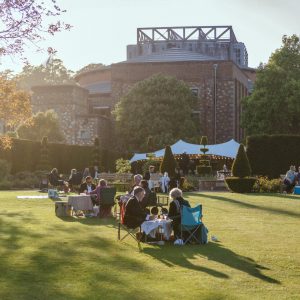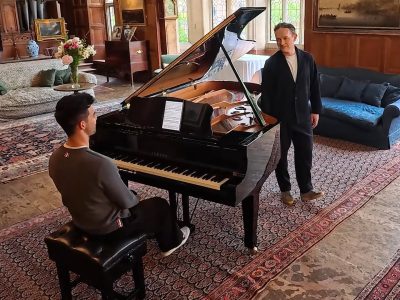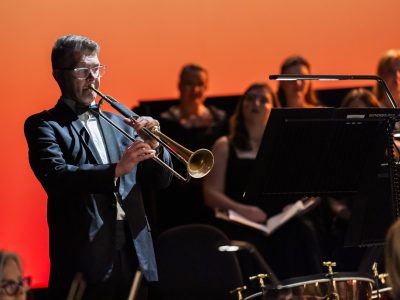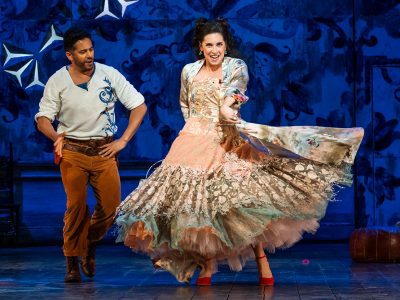
Digitising Così fan tutte
Our Archivist Philip Boot gives an update about our exciting digitisation project, and shares rarely seen images from some of our earliest productions of Mozart’s Così fan tutte.
Yet, one of the more positive aspects of last year was that it allowed the Glyndebourne Archive to step back, take a deep breath and have a good look at the collections we hold and care for. It gave us the opportunity to look at the artworks, designs, costumes and photographic collections we hold and to focus on how to make them more accessible to audiences and Members. An opportunity that we would perhaps not have had in other circumstances.
One of the projects born from this moment of reflection was to focus on digitising some of our earliest photography collections. We are very lucky that Glyndebourne had the foresight in 1934, the first Festival, to allow photographers onsite, something that has happened every year since. As a result, the photographic collections held by the Archive are superb. A collection that is significant not only to Glyndebourne, but to British and international theatre and opera. Early photographers at Glyndebourne include Angus McBean, Ilse Bing, Antony Armstrong-Jones, 1st Earl of Snowdon and Bill Brandt.

Così fan tutte, Edinburgh Festival, 1949. Photo: Angus McBean
Digitising the photographs has allowed for us to revisit some of the very first productions staged. One production that cropped up again and again was Mozart’s Così fan tutte, an opera that was performed every year from 1934 until the outbreak of the Second World War. The photographs serve as a reminder of the sheer artistry and high standards of productions performed at Glyndebourne, from the very first year through to today.
It is clear from looking at the photographs of Così fan tutte that different images were taken for different purposes; some for press, others by professional photographers (some of whom were artists in their own right), whilst some (often taken by staff) are simply a documentary record of those early achievements in British opera.
When looking through the photographic collections within the Archive, it is hard not to reflect on the different productions over the years. When comparing the photographs from the very first Così fan tutte production in 1934, through to the current production that first premiered at Glyndebourne in 2006 (to be revived in Festival 2021), they look remarkably similar. The 1934 production, with sets designed by Hamish Wilson and costumes by his sister, Ann Litherland, showcases a very traditional staging of the opera. Coupled with Wilson’s modernist sensibilities, the production was an instant hit. Looking at photography from our most recent production, which debuted in 2006 and was designed by Vicki Mortimer, we can see that while it is more imposing than the 1934 production, is not dissimilar to the original. Again, we see a very traditional approach to the costume and set design. And again, an instant hit with critics and audiences.

Così fan tutte, 1934. Glyndebourne Archive Collection

Così fan tutte, 2006. Photo: Guy Gravett
Post-war, Così fan tutte returned to Glyndebourne in 1950 (though it had been performed at the Edinburgh Festival in 1948 and 1949) in a new production designed by Rolf Gerard. The photographs from this period mark a shift in style in both photography and the production. Angus McBean became Glyndebourne’s in-house photographer for a short period of time, bringing his unique and distinctive style. Inspired by the International Surrealist exhibitions in 1936 and 1937, McBean’s photographs typically make use of the props and staging to create marvellous scenes, lighting them specifically for the photograph, directing the performers where to stand and what pose to strike. During this period, Glyndebourne would also use the photographer Guy Gravett. Gravett, who photographed productions between 1951 until 1996, would photograph Così fan tutte in his first season at Glyndebourne. Though both McBean and Gravett staged their production photography (Gravett would photograph both live and staged scenes during his time at Glyndebourne) the stylistic differences between the two are clear.
It is incredibly important for the Archive to actively preserve these photographic collections, both physically and digitally. They serve as a reminder of Glyndebourne’s achievements, the accomplishments of British opera, the sheer talent of performers, designers, directors and producers, as a documentary record, and form an important part of our collective memory as audience members, Glyndebourne members, staff and artists.
By Philip Boot, Glyndebourne Archivist
Help set the spotlight on Così fan tutte.
Support the return of Così fan tutte in the 2021 Glyndebourne Festival by joining a Production Circle from £5,000+ or Syndicate from £20,000.
Gain an insider view of the creative process through special events and invites to rehearsals. Deepen your involvement and enjoy year-round benefits plus a tailored relationship with Glyndebourne.
To find out more about how to support this production click the button above, or email development@glyndebourne.com. We’d love to hear from you if you are interested in supporting this area of Glyndebourne’s work.














